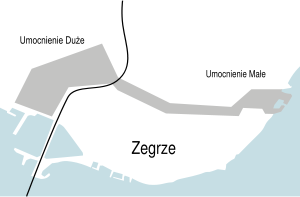
Ostrołęka(listen) is a city in northeastern Poland on the Narew river, about 120 km (75 mi) northeast of Warsaw, with a population of 52,792 (2014) and an area of 33,46 km2. The town is situated in the Masovian Voivodeship, and it is the former capital of the Ostrołęka Voivodeship (1975–1998). Ostrołęka is currently the capital of both Ostrołęka County and Ostrołęka City County. Until the late 1980s, Ostrołęka used to be a local railroad junction, with four lines stemming from Ostrołęka railway station: eastwards to Łapy and Białystok, southwestwards to Tłuszcz and Warsaw, northwards to Wielbark and Olsztyn, and southwards to Małkinia.

The Siege of Warsaw in 1939 was fought between the Polish Warsaw Army garrisoned and entrenched in Warsaw and the invading German Army.
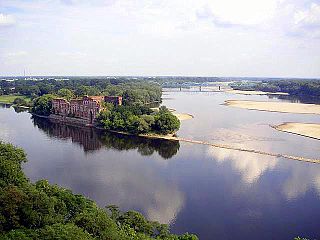
Modlin Fortress is one of the largest 19th-century fortresses in Poland. It is located in the town of Nowy Dwór Mazowiecki in district Modlin on the Narew river, approximately 50 kilometers north of Warsaw. Originally constructed by the French in the years 1806–1812, the main barrack located within the complex is the longest building in Europe at 2,250 meters in length.

Warsaw Fortress was a system of fortifications built in Warsaw, Poland during the 19th century when the city was part of the Russian Empire. The fortress belonged to a chain of fortresses built in Congress Poland and the region adjacent to it during this period. It was built in stages, with the first part, known as Warsaw Citadel, built the years 1832-1834, in the immediate aftermath of the November Uprising of 1830. This initial fortification was then continually improved by the addition of further forts in its vicinity, with the work finally completed in 1874. In 1879 the government of the Russian Empire decided to carry ouf a major expansion of the fortress, which would incorporate a system of large forts surrounding the whole city. 20 forts forming this new system were constructed between 1883 and 1890. There were plans to combine the Warsaw fortress with the nearby Modlin Fortress by building a chain of connecting forts, but this work was carried out only partially. The rapid progress in the power of siege artillery required the forts to be continually strengthened. In the final period of its existence the fortress consisted of 29 forts and major works, including the older forts of the original Citadel, which were reinforced by numerous smaller fieldworks.

Modlin was a village near Warsaw in Poland near the banks of rivers Narew and Vistula. In 1961 it was incorporated into the town of Nowy Dwór Mazowiecki.

The Battle of Mława, otherwise known as the Defence of the Mława position, took place to the north of the town of Mława in northern Poland between 1 and 3 September 1939. It was one of the opening battles of the Invasion of Poland and World War II in general. It was fought between the forces of the Polish Modlin Army under General Krukowicz-Przedrzymirski and the German 3rd Army under General Georg von Küchler.

Serock is a town at the north bank of the Zegrze lake in the Legionowo County, Masovian Voivodeship, Poland, around 40 kilometres north of Warsaw. It has 4,109 inhabitants (2013).

The Western Russian fortresses are a system of fortifications built by the Russian Empire in Eastern Europe in the early 19th century. The fortifications were constructed in three chains at strategic locations along Russia's western border, primarily to combat the threat of Prussia and Austria-Hungary, and to establish Russian rule in new western territories. By the late 19th century the fortifications were obsolete and the system became defunct by the collapse of the Russian Empire in 1917.
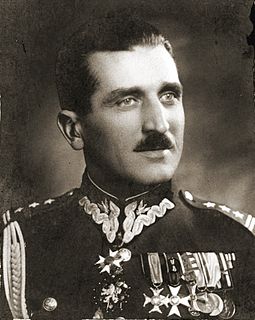
Wincenty Kowalski (1892–1984) was a Polish military commander and a general of the Polish Army. A veteran of both World War I and World War II, he fought in all the inter-war conflicts of Poland. During the Invasion of Poland of 1939 he commanded the Polish 1st Legions Infantry Division.

Zakroczym is a small town in the Masovian Voivodeship, Poland. It is located at around 52°26′16″N20°36′43″E. The Vistula River flows through the town. Zakroczym has a long and rich history: in the Kingdom of Poland and the Polish-Lithuanian Commonwealth, it was the capital of an administrative unit (ziemia), part of Mazovian Voivodeship. Also, Zakroczym was a royal town of the Crown of the Kingdom of Poland. The town lies at the intersection of two main roads - national road 62, and national road 7.

The Battle of Nowy Dwór was fought during September 20 – September 30, 1655 between forces of the Polish–Lithuanian Commonwealth commanded by Jan Kazimierz Krasiński on one side, and on the other Swedish Empire forces commanded by Gustaf Otto Stenbock. It ended in Swedish victory.

Modlin Army was one of the Polish armies that took part in the Invasion of Poland in 1939. After heavy casualties in the battle of Mława, the Army was forced to abandon its positions near Warsaw around September 10; eventually it took part in the battle of Tomaszów Mazowiecki and surrendered afterwards.
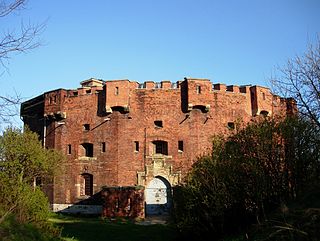
Kraków fortress refers in the narrow sense to the 19th century Austro-Hungarian fortifications, and in the larger sense - to the interconnected fortifications in Kraków, Poland, including 18th century Kościuszko Insurrection fortifications, and the medieval Wawel castle and city walls.

Wieliszew is a village in Legionowo County, Masovian Voivodeship, in east-central Poland, in the bifurcation of the Vistula and Narew Rivers. It is the seat of the gmina called Gmina Wieliszew. It lies approximately 7 kilometres (4 mi) north-east of Legionowo and 26 km (16 mi) north of Warsaw.
Fort Beniaminów is a military installation in Beniaminów, some 20 kilometres (12 mi) east of Warsaw. Designed by a Polish-born Russian General Konstanty Wieliczko, the fort was constructed in 1904 as part of the outer ring of defences of the Warsaw Fortress. Conveniently located near the southern bank of Bugonarew, it was to shield the then-Russian city of Warsaw from an enemy force trying to attack it from the East: possibly a German Army trying to outflank the Russian army from East Prussia. It was to cooperate with two earlier forts in Wawer and Kawęczyn and two more modern forts in Pustelniki and Maciołki.

The Battle of Radzymin took place during the Polish–Soviet War (1919–21). The battle occurred near the town of Radzymin, some 20 kilometres (12 mi) north-east of Warsaw, between August 13 and 16, 1920. Along with the Battle of Ossów and the Polish counteroffensive from the Wieprz River area, this engagement was a key part of what later became known as the Battle of Warsaw. It also proved to be one of the bloodiest and most intense battles of the Polish-Soviet War.

The Siege of Novogeorgievsk was a battle of World War I fought after the Germans broke the Russian defenses at the Gorlice–Tarnów Offensive and approached Warsaw.

Battle of Łomża was a series of armed engagements during the Nazi German and Soviet Invasion of Poland. The battle took place in and around the town of Łomża, on both sides of the Narew River. Polish forces successfully held a series of pre-First World War forts from repeated German attack before being forced to withdraw due to the position becoming untenable following their losses at the Battle of Wizna and Battle of Nowogród.
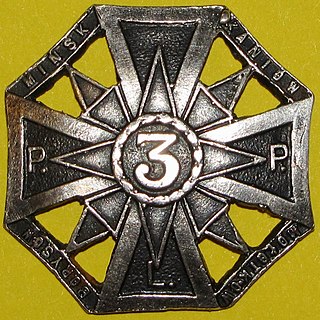
Third Legions Infantry Regiment was an infantry unit of Polish Legions in World War I, Polish Army and the Home Army. It existed in 1914–1939 and 1944–1945.

The Granary on the Narew river is a granary built in 1838-44 in Nowy Dwór Mazowiecki near the mouth of the Narew river in north-eastern Poland.
